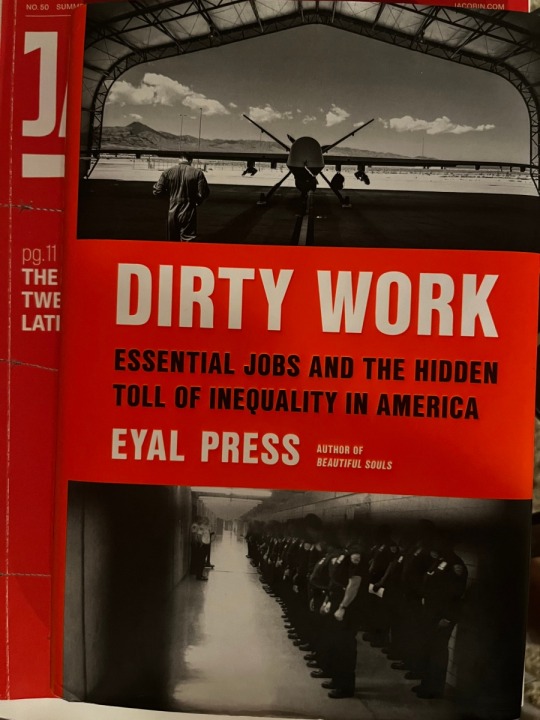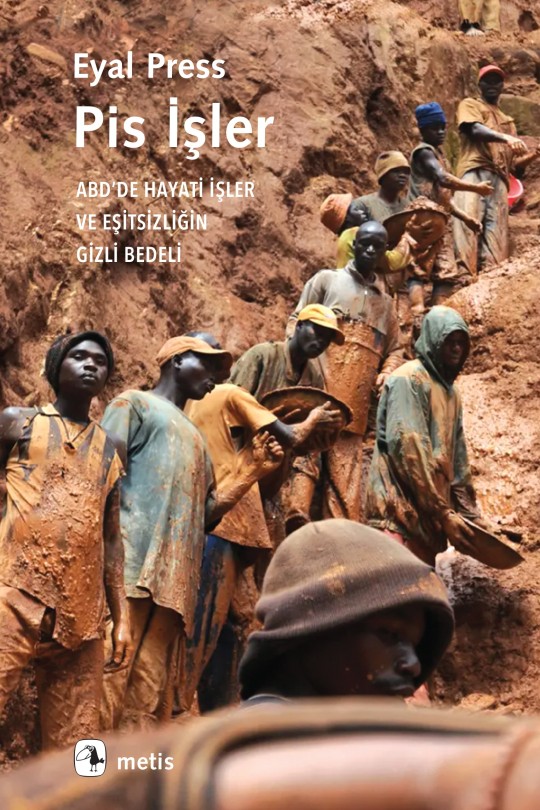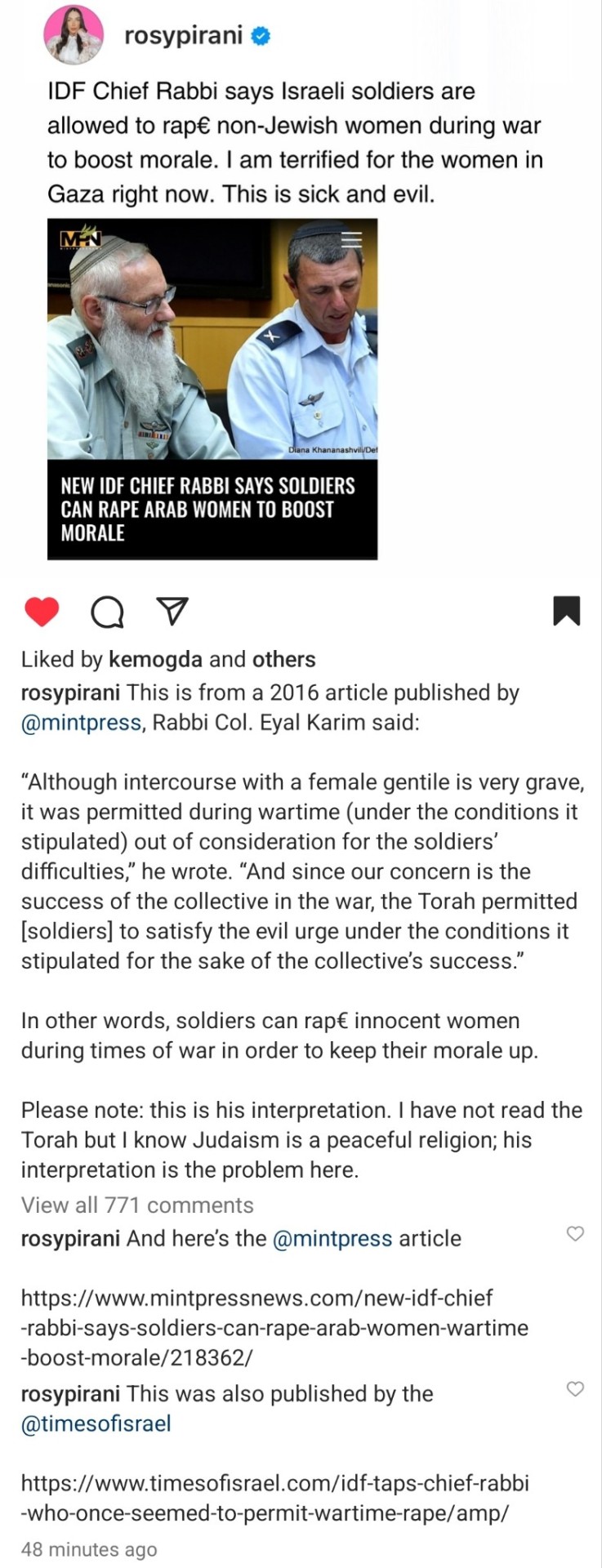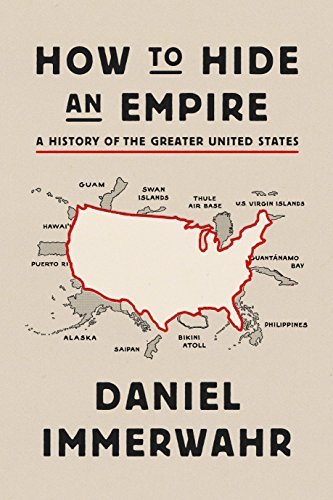#eyal press
Text
[“One author of the Clinical Psychology Review article was Shira Maguen, a researcher who began to think about the moral burdens of warfare while counseling veterans at a PTSD clinic in Boston.
Like most Veterans Affairs psychologists, Maguen had been trained to focus on the aftershocks of fear-based trauma—IED blasts that ripped through soldiers’ Humvees, skirmishes that killed members of their unit. The link between PTSD and such “life-threat” events was firmly established. Yet in many of the cases she observed, the source of distress seemed to lie elsewhere: not in attacks by the enemy that veterans had survived, but in acts they had observed or carried out that crossed their own ethical lines.
Soldiers were not, of course, the only people who risked committing such transgressions. All of the counselors I interviewed at the Dade Correctional Institution struggled with inner conflicts related to horrifying things they’d witnessed but failed to prevent. What kind of person was she? Lovita Richardson wondered after seeing a prisoner bound to a chair get bludgeoned and not intervening to help him. “Why didn’t I do more?” Harriet Krzykowski asked herself after learning about the “shower treatment.” Many of the prison guards I’d interviewed had alluded to incidents where they’d done things they knew they shouldn’t, as when Bill Curtis slammed a man to the ground, nearly fracturing his skull. Moral injuries were an occupational hazard for anyone whose job involved “perpetrating, failing to prevent, or bearing witness to acts that transgress deeply held moral beliefs.” For most dirty workers, that is.
Among the veterans she counseled, Maguen grew particularly interested in the emotional toll of killing, which was sanctioned in the military but not when defenseless civilians were involved. “I was hearing about experiences where people killed and they thought they were making the right decision,” she told me, “and then they found out there was a family in the car.” To find out how heavy the burden of killing was, Maguen began combing through the databases in which veterans of conflicts dating back to the Vietnam War were asked if they had killed someone while in uniform. In some cases, veterans were also asked whom they killed—combatants, prisoners of war, civilians. Maguen wanted to see if there might be a relationship between taking another life and debilitating consequences like alcohol abuse, relationship problems, outbursts of violence, PTSD. The results were striking: even when controlling for different experiences in combat, she found, killing was a “significant, independent predictor of multiple mental health symptoms” and of social dysfunction.
Later, when she started directing a mental health clinic at a VA hospital in San Francisco, Maguen convened groups where veterans came together and talked about the killing they had done. In the VA no less than in the military, this was a taboo subject, so much so that clinicians often referred to it euphemistically, if at all. To ease the tension, a scene from a documentary was shown at the beginning of each session in which a veteran said, “Out there, it’s either kill or be killed. Nothing can really prepare you for war.” Afterward, Maguen would ask the veterans in the room a series of questions about how killing had impacted their lives. Some reacted angrily. Others fell silent. But many seized the opportunity to talk about experiences they later told Maguen they had never spoken about with anyone, not even their spouses and family members, for fear of being judged.
The veterans in Maguen’s groups didn’t talk a lot about fear and hyperarousal, emotions linked to PTSD. Mostly, they expressed self-condemnation and guilt. “You feel ashamed of what you did,” one said. Others described feeling unworthy of forgiveness and love. The passage of time did little to diminish the depth of these feelings, Maguen found. Geographic distance didn’t lessen them much either. Maguen recounted the story of a pilot who was haunted by the bombs he had dropped on victims far below. What troubled him was, in fact, precisely his distance from them—that instead of squaring off against the enemy in a fair fight, he had killed in a way that lacked valor. Obviously not all pilots felt this way. But the story underscored the significance of something Maguen had come to regard as more important than proximity or distance in shaping moral injury—namely, how veterans made sense of what they had done. “How you conceptualize what you did and what happened makes such a big difference,” she said. “It makes all the difference.”
Unlike PTSD, moral injury was not a medical diagnosis. It was an attempt to capture what could happen to a person’s identity and soul in the crucible of war, which is why it struck a chord among veterans who did not feel their wounds could be reduced to a medical disorder. “PTSD as a diagnosis has a tendency to depoliticize a veteran’s disquietude and turn it into a mental disorder,” observed Tyler Boudreau, a marine officer who served in Iraq and came back haunted by doubts about the war’s morality. “What’s most useful about the term ‘moral injury’ is that it takes the problem out of the hands of the mental health profession and the military and attempts to place it where it belongs—in society, in the community, and in the family—precisely where moral questions should be posed and wrangled with. It transforms ‘patients’ back into citizens and ‘diagnoses’ into dialogue.”]
eyal press, from dirty work: essential labor and the hidden toll of inequality in america, 2021
191 notes
·
View notes
Text
Cont. to read Dirty Work
Ch. 3 Prisons have always been geographically isolated and visually lackluster, I assumed after these visits, the better to avoid attracting unwanted attention from outsiders. As I subsequently learned, this assumption was wrong. During the Jacksonian era, “Americans took enormous pride in their prisons, were eager to show them off to European visitors, and boasted that the United States had ushered in a new era in the history of crime and punishment,” notes the historian David Rothman.
Among the visitors invited to see the early prisons of the new republic was Charles Dickens, who toured the grounds of Pennsylvania’s Eastern State Penitentiary in 1842, chatting freely with convicts as he passed from cell to cell. “Nothing was concealed or hidden from my view,” Dickens wrote in his American Notes, “and every piece of information that I sought, was openly and frankly given.” In both America and England, prisons in the nineteenth century tended to be built in prominent places that were exposed to the public. Some boasted soaring turrets and stone arcades and were likened to palaces.
At the time, America’s penal system was shaped by a belief that prisons could be designed to foster moral uplift and turn chastened offenders into law-abiding citizens. By the 1980s, a more punitive philosophy had taken hold, which made prison administrators and public officials all the more inclined to limit access to their grounds.
But the shift to the margins of society could also be attributed to something else. In Pratt’s view, it reflected the triumph of “civilized punishment”—civilized not in the conventional meaning of the term, but in the sense that Norbert Elias described, whereby distasteful and disturbing events were removed from sight and pushed “behind the scenes of social life.”
...In Discipline and Punish, Michel Foucault argued that the transition to the more refined technologies of punishment in the modern era—most notably, the prison—was driven by the desire to control and observe the bodies of criminals, rendering them docile and obedient. Criminologists influenced by Elias have emphasized another rationale, arguing that the shift was propelled by a desire to hide these bodies from respectable citizens who no longer wanted to glimpse the sordid business of punishment with their own eyes.
The fact that corporal punishment came to be viewed as sordid was, in theory, a sign of progress. Yet as Elias’s disciples have noted, the “civilizing process” he outlined did not suggest that brutal violence would cease, only that it would be relegated to more private spaces. According to the scholar David Garland, who introduced Elias’s work to the sociology of punishment, violence would not offend civilized sensibilities so long as it unfolded behind closed doors or could be sanitized.
...Flogging prisoners clearly violated the “threshold of repugnance” among modern Americans. But caging them in hidden, segregated “isolation units” did not. The fact that solitary confinement’s “ghastly signs and tokens are not so palpable to the eye,” as Dickens had observed in 1842, was precisely why so many people failed to find it offensive. “Routine violence and suffering can be tolerated on condition that it is discreet, disguised, or somehow removed from view,” observed Garland. What mattered was not the level of brutality, but its visibility and form. Viewed in this light, the remoteness of Florida’s prisons was not an accident. Throughout the Western world, “the civilized prison became the invisible prison,” Pratt observed, hiding the system’s violence and making it that much easier for “good people” to ignore or forget about what was happening behind the walls.
1 note
·
View note
Text
Work till you drop
Dirty Work: Essential Jobs and the Hidden Toll of Inequality in AmericaBy Eyal Press270 pp. Farrar, Straus Giroux. $28.
A deep dive into what capitalism has wrought in America and its labor force today. You know the truth — a lot of the work that’s deemed “essential” in this country, and throughout much of the West, is work that’s heavily stigmatized. By the same token, many of those who are…

View On WordPress
0 notes
Text
Eyal Press – Pis İşler (2023)
Toplu olarak yaşamanın parçası olan çeşitli “pis işler” var.
Sadece ağır ve zor değil aynı zamanda adı kötüye çıkmış, yani saygınlıktan uzak sayılan işler.
Geleneksel toplumlarda bu tür işleri yapanlara yönelik bariz dışlama mekanizmaları vardı.
Bugünkü toplumlarımızda açıktan açığa böyle bir işleyiş olmasa da “pis işleri” yapanların toplumsal konumları daha iyi değil.
Eskiden toplumların en…

View On WordPress
#2023#ABD’de Hayati İşler ve Eşitsizliğin Gizli Bedeli#Deniz Keskin#Eyal Press#Metis Yayınları#Pis İşler
0 notes
Text
[Calcalist is Private Israeli Media]
"We have a huge deficit of ammunition not just in Ukraine but all over the world. We understand we should produce this here in Ukraine because all around the world it’s finished, it’s depleted. All the warehouses are empty," said Ukrainian Prime Minister Denys Shmyhal to the "Financial Times" in October of last year, addressing the ammunition situation of the Ukrainian army, which is interconnected with the challenges faced by the IDF.
The increased ammunition usage in the wars in Gaza and Ukraine has led to an unprecedented global shortage of ammunition of all types. While the IDF tries not to address the issue publicly, Major General Eliezer Toledano admitted last month that the IDF is reducing air attacks, emphasizing the necessity to "manage the economy of armaments" because the war will last a long time. Prime Minister Benjamin Netanyahu also commented on the matter, stating that "we need three things from the U.S.: armaments, armaments, armaments." At a press conference two weeks ago, Netanyahu announced that Israel is preparing the Israeli defense industries to "cut off dependence on the world," a goal that is not realistic in any way.[...]
[L]ast week the Director General of the Ministry of Defense Eyal Zamir concluded a huge deal with the American government for the supply of aerial ammunition in the hundreds of millions of dollars, and so far over 25,000 tons of weapons have been sent to Israel since the beginning of the war in about 280 aircraft and about 40 ships. The Israeli defense industry is also tasked with filling the IDF's stocks. About two weeks ago it was published in Calcalist that the Israeli companies postponed the supply of weapons worth more than $1.5 billion to their customers across the world to divert resources for the IDF's combat needs and that in the last three months, the Ministry of Defense ordered more than NIS 10 billion ($2.7 million) worth of weapons from them. It should be noted that the shortage does not stem from a lack of budget but from a lack of supply, and the Treasury does not restrict the IDF from purchasing ammunition of any kind.
The tremendous need for armaments stems from the unusual amount of bombings that the IDF has carried out in Gaza since the outbreak of the war. Two weeks ago, the army announced that 30,000 targets had been attacked in Gaza. A security source told Calcalist that the rate of fire the IDF is using in the current war is similar to that of a "superpower," is comparable only to the capabilities demonstrated by the U.S., and probably also exceeds the number of armaments of the Russians in the campaign against Ukraine.[...]
Another reason [for the increase in targets bombed] is that in the current war, the IDF adopted a policy of a lighter finger on the trigger [sic] regarding damage to infrastructure and Hamas operatives who are in a civilian environment, thus increasing the ability to hit targets that were not previously attacked. In addition to these reasons, there is also the added pressure from the political level, as well as from the [Israeli] public, who demand an increase in air force bombing to prevent as much as possible a risk to the forces on the ground.[...]
[O]ne should ask whether, considering the existing ammunition stockpile, this policy may not harm the IDF's readiness to carry out future missions, especially given the existing security challenges and the probable scenario in which the IDF will be forced to [sic] carry out an attack in southern Lebanon as well. The IDF may be forced to better clarify its limitations to the politicians to avoid reaching an extreme scenario of an ammunition shortage, or in the words of General Toledano: "There is no infinite army."
28 Jan 24
318 notes
·
View notes
Text
I put off reading Eyal Press' Dirty Work for a long time because I knew it would a deeply upsetting read, and it is, but I still can't recommend it enough. It is genuinely, morally upsetting to think about the suffering that gets hidden were it won't upset us and how it can make us glib.
90 notes
·
View notes
Text
Check it out - Haymarket Books has a free collection of essays about Gaza. Description from the site:
In the final months of 2023, as this ebook is published, Israel is committing a genocide in Gaza. Israeli officials have repeatedly made their intentions to do so extremely clear; talking of collective punishment, mass murder, and ethnic cleansing in newspapers, at press conferences, and on television. All the while, European and American states have continued to support Israel, to claim its murderous campaign is justified self-defense, and to send weapons, troops, war boats, and spy planes. While Western governments have supported the unjustifiable, or spoken inane words of condemnation while failing to take any concrete action, millions around the world have poured into the streets to denounce their complicity, to demand a ceasefire and a free Palestine.
From the River to the Sea collects personal testimonies from within Gaza and the West Bank, along with essays and interviews that collectively provide crucial histories and analyses to help us understand how we got to the nightmarish present. They place Israel’s genocidal campaign within the longer history of settler colonialism in Palestine, and Hamas within the longer histories of Palestinian resistance and the so-called “peace process.” They explore the complex history of Palestine’s relationship to Jordan, Egypt, and the broader Middle East, the eruption of unprecedented anti-Zionist Jewish protest in the US, the alarming escalation in state repression of Palestine solidarity in Britain and Europe, and more. Taken together, the essays comprising this collection provide important grounding for the urgent discussions taking place across the Palestine solidarity movement.
With contributions from: Reda Abu Assi, Asmaa Abu Mezied, Tawfiq Abu Shomer, Khalil Abu Yahia, Dunia Aburahma, Spencer Ackerman, Hil Aked, Yousef Al-Akkad, Jamie Allinson, Hammam Alloh, Riya Al’Sanah, Soheir Asaad, Tareq Baconi, Rana Barakat, Omar Barghouti, Sara Besaiso, Ashley Bohrer, Haim Bresheeth-Zabner, Nihal El Aasar, Mohammed El-Kurd, Sai Englert, Noura Erakat, Samera Esmeir, Rebecca Ruth Gould, Toufic Haddad, Adam Hanieh, Khaled Hroub, Rashid Khalidi, Noah Kulwin, Saree Makdisi, Ghassan Najjar, Samar Saeed, Reema Saleh, Alberto Toscano, and Eyal Weizman, alongside a number of Palestinian writers published pseudonymously.
Published in collaboration with Verso Books
Cover design: Tom Greenwood
22 notes
·
View notes
Text

From the River to the Sea: Essays for a Free Palestine
Edited by Sai Englert, Michal Schatz and Rosie Warren
In the final months of 2023, as this ebook is published, Israel is committing a genocide in Gaza. Israeli officials have repeatedly made their intentions to do so extremely clear; talking of collective punishment, mass murder, and ethnic cleansing in newspapers, at press conferences and on television. All the while, European and American states have continued to support Israel, to claim its murderous campaign is justified self-defence, and to send weapons, troops, war boats and spy planes in support. While Western governments have supported the unjustifiable, or spoken inane words of condemnation while failing to take any concrete action, millions around the world have poured into the streets to denounce their complicity, to demand a ceasefire and a free Palestine.
From the River to the Sea collects personal testimonies from within Gaza and the West Bank, along with essays and interviews that collectively provide crucial histories and analyses to help us understand how we got to the nightmarish present. They place Israel’s genocidal campaign within the longer history of settler colonialism in Palestine, and Hamas within the longer histories of Palestinian resistance and the so-called ‘peace process’. They explore the complex history of Palestine’s relationship to Jordan, Egypt, and the broader Middle East, the eruption of unprecedented anti-Zionist Jewish protest in the US, the alarming escalation in state repression of Palestine solidarity in Britain and Europe, and more. Taken together, the essays comprising this collection provide important grounding for the urgent discussions taking place across the Palestine solidarity movement.
With contributions from: Dr. Reda Abu Assi, Asmaa Abu Mezied, Tawfiq Abu Shomer, Khalil Abu Yahia, Dunia Aburahma, Spencer Ackerman, Hil Aked, Dr. Yousef Al-Akkad, Jamie Allinson, Dr. Hammam Alloh, Riya Al’Sanah, Soheir Asaad, Tareq Baconi, Rana Barakat, Omar Barghouti, Sara Besaiso, Ashley Bohrer, Haim Bresheeth-Žabner, Nihal El Aasar, Mohammed El-Kurd, Sai Englert, Noura Erakat, Samera Esmeir, Rebecca Ruth Gould, Toufic Haddad, Adam Hanieh, Khaled Hroub, Rashid Khalidi, Noah Kulwin, Saree Makdisi, Ghassan Najjar, Samar Saeed, Reema Saleh, Alberto Toscano and Eyal Weizman, alongside a number of Palestinian writers published pseudonymously.
Published in collaboration with Haymarket Books.
Cover design: Tom Greenwood.
#gaza#genocide#palestine#book review#free books#goodreads#nakba#settlement#settler colonialism#محكمة العدل الدولية#International Court of Justice#ICJ#ICC#NEWS#current events#ALJAZEERA#CNN#TEL AVIV#jerusalem
6 notes
·
View notes
Text

(via. rosypirani)
IDF Chief Rabbi says Israeli soldiers are allowed to rap€ non-jewish women during war to boost morale. I am terrified for the women in Gaza right now. This is sick and evil.
Caption: This is from a 2016 article published by mintpress, Rabbi Col. Eyal Karim said:
"Although intercourse with a female gentiles very grave, it was permitted during wartime (under the conditions it stipulated) out of consideration for the soldiers' difficulty," he wrote. "And since our concern is the success of the collective in the war, the Torah permitted [soldiers] to satisfy the evil urge under the conditions it stipulated for the sake of the collective's success."
In other words, soldiers can rap€ innocent women during times of war in order to keep their morale up.
Please note: This is his interpretation. I have not read the Torah but I know Judaism is a peaceful religion; his interpretation is the problem.
Mint Press News 2016 article:
Times of Israel 2016 article:
#IDF Chief Rabbi Eyal Kerim#tw rape#free palestine#palestine#israeli war crimes#end israeli siege#end israeli occupation#end israeli apartheid#humanitarian crisis#human rights
9 notes
·
View notes
Text

Israel is close to acquiring more F-35I, F-15IA fighters and Apache helicopters
Fernando Valduga By Fernando Valduga 01/27/2024 - 18:05 in Military
According to reports from the Israeli press, the Israeli military announced the intention to soon conclude a major multibilion-dollar arms agreement with the United States, which includes the sale of 25 additional F-35I "Adir" fighters and 25 more F-15IA fighters, along with at least 12 additional AH-64D Apache attack helicopters and a continuous supply of ammunition.
This agreement has been ongoing since last year, with initial deliveries scheduled for 2027. However, the Israeli government hopes that, in the middle of the war in Gaza and the fight against Iranian-backed groups, some deliveries can be accelerated and begin in the coming months. The subscription is scheduled for the next few weeks.

Last week, on the 25th, the Director General of the Ministry of Defense, Eyal Zamir, ended a working visit to Washington, during which he met with senior officials from the Pentagon and the State Department, as well as executives of leading U.S. defense companies to discuss the advance agreements for additional F-35, F-15 and Apaches for Israel
Defense sources would have told the Times of Israel that Israel's plans to acquire a new squadron of 25 F-35I stealth combat aircraft, a squadron of 25 F-15IA combat aircraft and a squad of 12 Apache combat helicopters, would have advanced during discussions with the United States. Last year, Israel made formal requests to the United States regarding the purchase of F-35 fighters and F-15 jets.
The number of new aircraft ordered is quite significant. Tel Aviv is trying to expand and upgrade its current F-15IA fleet, which can carry the kind of heavy weapons that Israel would need to attack Iranian nuclear facilities, most of which are buried underground. While the 50% increase in F-35Is will increase Lightning's stealth capabilities to attack strategic targets in the Middle East at any time and with absolute discretion.

This was also the case in November 2023, when Damascus airport in Syria was bombed by Israeli F-35s, which are also used for air-to-air missions, as demonstrated by the slaughter, again in November 2023, of a cruise ship with missiles launched into Israeli airspace by Houthi rebels.
The acquisition of Apache helicopters would instead follow the lessons learned from the Hamas attack on October 7, 2023, during which about 3,000 Hamas-led terrorists attacked southern Israel, killing about 1,200 people and taking 253 hostages, mostly civilians, and the fighting in the Gaza Strip. Today Israel operates 26 AH-64A Apaches and 17 more modern AH-64D Apaches. Although the AH-64As have undergone some improvements and modernizations, the purchase order for 12 additional helicopters perhaps represents Israel's desire to replace some of its older Apaches.

There is still no immediate schedule for the delivery of fighters and helicopters, but Israel is expected to press for faster delivery. In addition, as part of the discussions with the United States, the Ministry of Defense delegation would also work to promote the continued supply of American ammunition to deal with the war in Gaza. Since the beginning of the war, at least 250 cargo planes and more than 20 ships have delivered more than 10,000 tons of weapons and military equipment to Israel.
For the agreements to be carried out and signed by Israel, government approval is required, a measure that defense sources say could happen in the coming weeks. Remember that Israel had already agreed to buy 50 F-35 fighters from Lockheed Martin, whose deliveries will continue until 2024.
Tags: AH-64 ApacheMilitary AviationF-15XF-35I 'Adir'IAF - Israeli Air Force/Israel Air Force
Sharing
tweet
Fernando Valduga
Fernando Valduga
Aviation photographer and pilot since 1992, he has participated in several events and air operations, such as Cruzex, AirVenture, Dayton Airshow and FIDAE. He has works published in specialized aviation magazines in Brazil and abroad. He uses Canon equipment during his photographic work in the world of aviation.
Related news
HELICOPTERS
VIDEO: First production MH-139 Grey Wolf takes off for testing
27/01/2024 - 17:20
MILITARY
US approves sale of 40 F-16 fighters to Turkey, worth US$ 23 billion
27/01/2024 - 15:03
HELICOPTERS
Dutch aviators receive new AH-64E Apache flight simulator
27/01/2024 - 14:39
MILITARY
United States approves sale of 40 F-35 fighters for $8.6 billion to Greece
27/01/2024 - 14:08
MILITARY
Jet that will become the first Swedish Saab GlobalEye arrives in Sweden.
26/01/2024 - 23:14
MILITARY
IMAGES: NATO Air Forces improve skills flying together over Lithuania
26/01/2024 - 17:00
2 notes
·
View notes
Text
[“The idea that work can be morally injurious has not gone entirely unnoticed. At the height of the coronavirus pandemic, it was described in often-moving detail in articles about physicians and nurses who were forced to make excruciating decisions—which patients should be hooked up to ventilators? who should be kept alive?—as hospitals were inundated with COVID-19 cases. “None of us will ever be the same,” wrote an ER doctor in New York City who worked on the front lines of the pandemic and published a firsthand account of the anguish that she and her colleagues felt.
Notably, though, it took an unforeseen crisis to thrust doctors into such a role, a crisis that eventually abated. In the case of many dirty workers, the wrenching choices—and the anguish they can cause—occur on a daily basis because of how society is organized and what their jobs entail. Unlike doctors, moreover, these workers are not lionized by their fellow citizens for working in a profession that is widely viewed as noble. To the contrary, they are stigmatized and shamed for doing low-status jobs of last resort.
People who are willing to do morally suspect things simply to earn a paycheck deserve to be shamed, some may contend. This is how many advocates of migrant rights feel about the Border Patrol agents who have enforced America’s inhumane immigration policies in recent years. It is why some peace activists have accused drone operators involved in targeted killings of having blood on their hands. These activists have a point.
The dirty workers whose stories unfold in the pages that follow are not the primary victims of the systems in which they serve. To the people on the receiving end of their actions, they are not victims at all. They are perpetrators, carrying out functions that often cause immense suffering and harm. But pinning the blame for dirty work solely on the people tasked with carrying it out can be a useful way to obscure the power dynamics and the layers of complicity that perpetuate their conduct. It can also deflect attention from the structural disadvantages that shape who ends up doing this work. Although there is no shortage of it to go around, the dirty work in America is not randomly distributed. As we shall see, it falls disproportionately to people with fewer choices and opportunities—high school graduates from depressed rural areas, undocumented immigrants, women, and people of color. Like jobs that pay poorly and are physically dangerous, such work is chiefly reserved for less privileged people who lack the skills and credentials, and the social mobility and power, that wealthier, more educated citizens possess.”]
eyal press, from dirty work: essential labor and the hidden toll of inequality in america, 2021
98 notes
·
View notes
Note
3, 4, 5, 9, 25!
3. What were your top five books of the year?
collected nonfiction by joan didion - i spent a week in january in the sacramento valley working my way through this book. i'd read stuff by her before, but this year some switch flipped in my brain and i Got it, i understood the obsession, the veneration... it's the details for me, the odd little turns of phrase, like "a little japanese on the horizon" describing the oilfields outside of LA, or the dress the color of the sac delta "for a few days in spring, when the rice first showed." didion would have snubbed me, descendant of okies and japanese immigrants, but i love seeing the landscape i was born and raised in refracted through her exacting, conservative mirror.
dear friend, from my life i write to you in your life by yiyun li - utterly obsessed with this. i can't describe the feeling it gives me, the quiet passage through a singularly strange and perfect mind. "had i been more disciplined, i would have written nothing and lost nothing." this is a book about being unable to convincingly describe a chrysanthemum.
the lover by marguerite duras - having a weird psychic moment with this book. "and it really was unto death. it has been unto death."
dispatches by michael herr - he mostly stopped writing after this. he saw that there was something basically fucked-up and evil about it, it being language, and especially the pathetic human use of it to conceal and protect. even worse, images; photos that appear to prove the existence of evil but communicate nothing behind it. which wasn't at all true of me, herr writes, father of all motherfuckers; i was here to watch.
dirty work by eyal press - i want everyone to read this book. it gave me a way to understand my world, a path to compassion, a path to forgiveness. i think about it constantly when i'm at my day job in the [redacted] world, and i want to make everyone i come into contact with read it too. we all follow orders; we all injure and are injured; we are all going to hell so that someone more fortunate doesn't have to.
4. Did you discover any new authors that you love this year?
CAN XUE!!!!!!!!! vertical motion blew my mind. also kind of getting into richard brautigan, i love his poems which are like haiku with bombs strapped inside of them.
5. What genre did you read the most of?
hard to say because i'll read anything... i did read a lot of nonfiction this year, plus my usual sci-fi detours.
9. Did you get into any new genres?
nah. i did have an intense philip k. dick moment though, does that count as a sci-fi subgenre?
25. What reading goals do you have for next year?
i want to get deeper into a few authors whose books i've loved recently but haven't read all of (robert walser, anna kavan, can xue); i want to read more poetry, and read poetry more adventurously; and i have a stack of hyperspecific nonfiction/history stuff on my shelf that i haven't cracked yet.
7 notes
·
View notes
Text
youtube
Watch the 2024 American Climate Leadership Awards for High School Students now: https://youtu.be/5C-bb9PoRLc
The recording is now available on ecoAmerica's YouTube channel for viewers to be inspired by student climate leaders! Join Aishah-Nyeta Brown & Jerome Foster II and be inspired by student climate leaders as we recognize the High School Student finalists. Watch now to find out which student received the $25,000 grand prize and top recognition!
#ACLA24#ACLA24HighSchoolStudents#youtube#youtube video#climate leaders#climate solutions#climate action#climate and environment#climate#climate change#climate and health#climate blog#climate justice#climate news#weather and climate#environmental news#environment#environmental awareness#environment and health#environmental#environmental issues#environmental education#environmental justice#environmental protection#environmental health#high school students#high school#youth#youth of america#school
18K notes
·
View notes
Text
Four Books To Radicalize You




How to Hide an Empire: A History of the Greater United States - Daniel Immerwahl
Animal, Vegetable, Junk: A History of Food, From Sustainable to Suicidal - Mark Bittman
Dirty Work: Essential Jobs and the Hidden Toll of Inequality in America - Eyal Press
The Secret Life of Groceries: The Dark Miracle of the American Supermarket - Benjamin Lorr
#book recs#book recommendations#food#politics#history#books#reading#reading list#labour#jobs#imperialism#colonialism#mine
13 notes
·
View notes
Note
32 for the ask game?
#32 is Dirty Work: Essential Jobs and the Hidden Toll of Inequality in America by Eyal Press, which I learned about when I was trying to actually read all of the articles I have saved in my twitter likes. it didn't work, but I did scoop some interesting new books to read!
3 notes
·
View notes
Text
tag game!
got tagged by @treebroski :)
favorite color: purple tones, especially velvety dark purples combined with shiny gold because im a decadent beast
currently reading: ‘Dirty Work: Essential Jobs and the Hidden Toll of Inequality in America” by Eyal Press. im reading it in chunks because man its a heavy, frustrating read. not frustrating in the ‘hard to understand/read’ way, but frustrating in the ‘i cant fucking believe we treat people like this and i dont personally have any real way to fix it’ way
sweet/salty/spicy/bitter/sour: spicy >:)
last song: ‘I don’t wanna talk’ by glass animals
last movie: silent night deadly night 2 with griff and kes its literally always such a joy to show that unspeakable trainwreck of a movie to people. clips dont do it justice you need to see every decision play out, every hastily shot and padded out scene, every eyebrow movement. i realized this last watch that the ‘theater’ scene was shot well after filming wrapped and you can tell because the dudes bleached mullet has grown out like two inches compared to the scene directly after it
currently working on: replaying yakuza0 and being soooooooooo normal about it, streaming bioshock, tending to my crustaceans, and restocking candles and getting body wash/lotion sets made
I tag: @mclaggington @cozybats @kaleuh @dulveyparish @sir-sammich only if yall wanna of course <3
5 notes
·
View notes
Text
US-Israel Defense Talks Focus on Regional Stability

Readout of Acting Under Secretary of Defense for Policy Ms. Sasha Baker and Under Secretary of Defense for Acquisition and Sustainment Dr. William A. LaPlante's Meeting With Israeli Ministry of Defense Director General Eyal Zamir
Strengthening U.S.-Israel Defense Ties
High-Level Pentagon Meeting
In a significant meeting at the Pentagon on January 24, key U.S. defense leaders, Acting Under Secretary of Defense for Policy Ms. Sasha Baker and Under Secretary of Defense for Acquisition & Sustainment Dr. William A. LaPlante, met with Israeli Ministry of Defense Director General Eyal Zamir. This encounter underlined the robust U.S.-Israel defense relationship and their shared strategic priorities.
Reaffirming U.S. Commitment to Israel's Security
The discussions reaffirmed the United States' unwavering commitment to Israel's security. The leaders explored various aspects of defense cooperation, reflecting a deep and enduring partnership between the two nations.
Addressing the Humanitarian Situation in Gaza
Focusing on Civilian Protection
A critical part of the dialogue involved the situation in Gaza. A/USDP Baker and DG Zamir reviewed Israel's targeted operations while emphasizing the need to protect civilians and ensure the provision of increased humanitarian assistance. This approach underscores the importance of balancing military actions with the well-being of civilian populations.
The Dire Situation of Children in Gaza
The meeting also highlighted the alarming conditions facing children in Gaza. Nearly 20,000 babies have been born into the conflict's recent escalation, facing immense challenges. UNICEF Deputy Executive Director Ted Chaiban's visit to Gaza brought attention to the children's lack of basic necessities and the constant fear and trauma they endure.
Addressing Regional Security and Tensions
Tackling Destabilizing Activities
A/USDP Baker and DG Zamir exchanged views on escalating regional tensions, particularly the destabilizing activities of Lebanese Hizballah in Lebanon and the Houthis in Yemen. The leaders agreed on the critical importance of preventing regional escalation, showcasing a joint commitment to maintaining stability in the Middle East.
Collaborative Approach to Middle East Security
The meeting highlighted the need for a cooperative approach to address security challenges in the Middle East. This involves not only military strategies but also diplomatic and humanitarian efforts to ensure long-term regional stability.
The Impact of the Gaza Conflict
Humanitarian Crisis and Response
The discussions acknowledged the humanitarian crisis in Gaza, with reports from UNICEF and other organizations emphasizing the urgent need for action. Furthermore, there are severe limitations in essential services like healthcare, water, and sanitation, which are compounded by the ongoing conflict.
Balancing Perspectives
In addressing the Gaza situation, it's crucial to maintain a balanced perspective. This includes considering the complex historical context and different narratives. Moreover, the meeting underscored the importance of fact-based discussions and the inclusion of various stakeholders' viewpoints. This includes humanitarian organizations and human rights groups.
In Conclusion
The Pentagon meeting between U.S. and Israeli defense leaders marked a significant step in reinforcing the U.S.-Israel defense relationship and addressing pressing regional issues. The talks emphasized the U.S. commitment to Israel's security, the need for humanitarian assistance in Gaza, and strategies to tackle regional tensions.
This meeting illustrates the continued collaboration and joint efforts to ensure stability and security in the Middle East, while being mindful of the humanitarian challenges, especially in conflict zones like Gaza.
Sources: THX News & US Department of Defense.
Read the full article
#GazaConflictEscalation#HumanitarianAssistanceinGaza#InternationalHumanitarianEfforts#IsraeliDefenseStrategies#MiddleEastSecurityChallenges#PentagonStrategicDiscussions#ProtectionofCivilians#Regionalsecuritycooperation#U.S.DefensePolicy#US-IsraelDefenseRelationship
0 notes
Text
youtube
Watch the American Climate Leadership Awards 2024 now: https://youtu.be/bWiW4Rp8vF0?feature=shared
The American Climate Leadership Awards 2024 broadcast recording is now available on ecoAmerica's YouTube channel for viewers to be inspired by active climate leaders. Watch to find out which finalist received the $50,000 grand prize! Hosted by Vanessa Hauc and featuring Bill McKibben and Katharine Hayhoe!
#ACLA24#ACLA24Leaders#youtube#youtube video#climate leaders#climate solutions#climate action#climate and environment#climate#climate change#climate and health#climate blog#climate justice#climate news#weather and climate#environmental news#environment#environmental awareness#environment and health#environmental#environmental issues#environmental justice#environment protection#environmental health#Youtube
17K notes
·
View notes